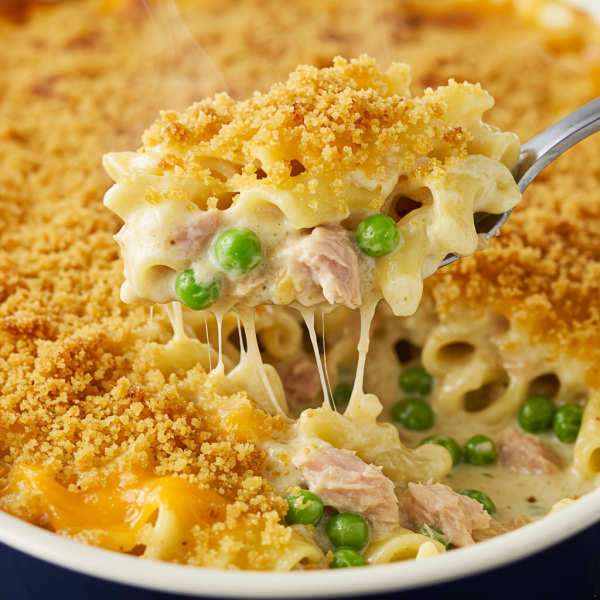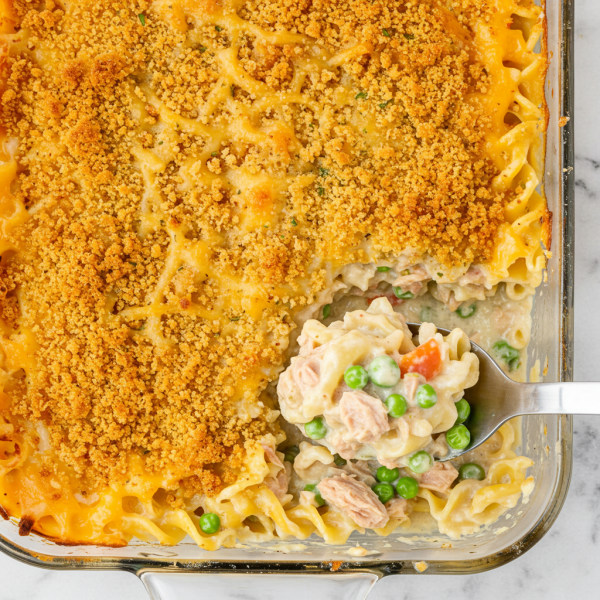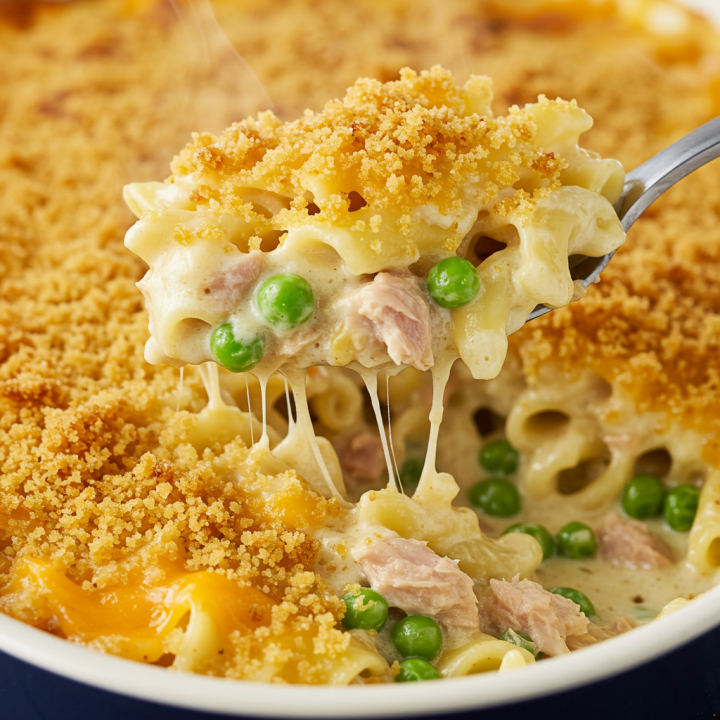This Is The Best Tuna Casserole Recipe You’ll Ever Find

This isn’t your grandma’s tuna casserole, unless your grandma was a culinary genius with a flair for turning the simple into the sublime.I’ll be honest, for years I avoided tuna casserole like the plague. My only experience with it was at church potlucks, where I’d see these giant pans of pale, mushy noodles swimming in a gray sauce. It was the definition of bland, a dish born of convenience that seemed to have forgotten all about flavor. It was a tummy filler, and that was about it. I just couldn’t bring myself to make something so uninspired in my own kitchen.
Then one rainy Tuesday, I was staring into my pantry, trying to figure out dinner. I saw the cans of tuna, the bag of egg noodles, and a block of cheddar cheese. The universe was practically screaming at me to make a tuna noodle casserole. But I was determined not to fall into the trap of a boring meal. I knew it had potential, it just needed a little love and a whole lot of personality.
So, I ditched the canned soup and made a creamy, dreamy béchamel sauce from scratch. I stirred in some sharp cheddar for a real cheesy bite. Then came the twist. I reached for two things that would change everything: a spoonful of tangy Dijon mustard and a generous shake of smoky paprika. That little bit of sharpness and smoke cut through the richness and brought the whole dish to life. It was a revelation, and it turned a humble pantry meal into a showstopper my family now asks for by name.
Why This Tuna Casserole Recipe Works
Tuna casserole is a true American classic, a staple of weeknight dinners and potluck tables for generations. Its story begins in the mid-20th century, a time when home cooks were embracing the magic of canned goods for creating quick, affordable, and filling meals for their families. Canned tuna, canned cream of mushroom soup, and pasta were inexpensive and shelf stable, making this dish a go to for busy households across the country.
While its origins are rooted in convenience, its staying power comes from its comforting nature. There’s something deeply satisfying about a warm, creamy, cheesy pasta dish. It’s the culinary equivalent of a cozy blanket on a chilly evening. It reminds people of childhood, of simpler times, and of family dinners around the table.
This particular tuna casserole recipe works because it honors that comforting tradition while elevating the flavors significantly. We’re not just opening cans here. We’re building layers of flavor from the ground up. By making a simple homemade cream sauce instead of using a canned soup, we control the ingredients and eliminate that overly processed taste. The sauce is richer, creamier, and serves as the perfect canvas for our flavor additions.
The real secret, as I mentioned, is the addition of Dijon mustard and smoked paprika. The Dijon adds a bright, tangy counterpoint to the creamy sauce and rich cheese, preventing the dish from feeling too heavy. The smoked paprika provides a subtle, smoky depth that complements the tuna beautifully. It’s a sophisticated touch that makes a world of difference. Topped with crunchy Panko breadcrumbs instead of soggy crackers, every bite has the perfect combination of creamy, savory, and crispy textures.
Ingredients for Tuna Casserole
The magic of this recipe lies in using simple, quality ingredients to build incredible flavor. While you can make a tuna casserole with just the basics, paying a little attention to the details, like the type of tuna and cheese you use, will pay off in the final dish. And of course, don’t skip the secret ingredients that give it that special pop!
- Egg Noodles: 12 ounces of wide egg noodles. Cooked al dente according to package directions.
- Butter: 1/4 cup of unsalted butter for the sauce, plus 2 tablespoons melted for the topping.
- All-Purpose Flour: 1/4 cup. This is what will thicken our homemade cream sauce.
- Milk: 2 cups of whole milk. For the richest, creamiest sauce, whole milk is best. You can use 2% but it won’t be quite as luxurious.
- Chicken Broth: 1/2 cup of low sodium chicken broth. It adds a layer of savory depth to the sauce that milk alone can’t provide.
- Sharp Cheddar Cheese: 2 cups shredded. Please, for the love of all that is good, shred your own cheese from a block! Pre-shredded cheeses are coated in starches that prevent them from melting as smoothly. A good sharp cheddar provides a fantastic flavor.
- Frozen Peas: 1 cup. No need to thaw them first, just toss them in straight from the freezer.
- Tuna: Two 5 ounce cans of solid white albacore tuna packed in oil, drained. Using tuna packed in oil makes a huge difference. It’s more flavorful and has a much better, firmer texture than tuna packed in water.
- Dijon Mustard: 1 tablespoon. This is one of our key ingredients! It adds a wonderful, zesty tang that cuts through the richness of the casserole.
- Smoked Paprika: 1 teaspoon. Our other secret weapon. The smoky flavor is absolutely divine with the tuna and cheese.
- Salt and Black Pepper: 1/2 teaspoon of each, or to your taste.
- Panko Breadcrumbs: 3/4 cup. These Japanese-style breadcrumbs are lighter and crispier than regular breadcrumbs and make for a superior crunchy topping.
Step-by-Step Instructions For Making Tuna Casserole
Bringing this incredible casserole together is a straightforward process. The key is making the sauce from scratch, but don’t you worry, it’s easier than it sounds! Just follow these steps, and you’ll have a perfect, bubbly tuna casserole ready for the oven in no time.
- Prep Your Station: Preheat your oven to 375°F (190°C). Lightly grease a 9×13 inch baking dish. Cook the egg noodles according to the package directions, but make sure to cook them al dente, usually about 1-2 minutes less than the recommended time. They will finish cooking in the oven. Drain the noodles well and set them aside.
- Make the Cream Sauce: In a large, heavy-bottomed pot or Dutch oven, melt 1/4 cup of butter over medium heat. Once it’s melted and bubbly, whisk in the 1/4 cup of flour. Cook, whisking constantly, for about one minute. This step cooks out the raw flour taste.
- Build the Béchamel: While still whisking, slowly pour in the 2 cups of milk and 1/2 cup of chicken broth. Keep whisking to prevent any lumps from forming. Continue to cook over medium heat, stirring frequently, until the sauce thickens enough to coat the back of a spoon. This should take about 5 to 7 minutes.
- Add the Flavor: Remove the sauce from the heat. Stir in the 1 tablespoon of Dijon mustard, 1 teaspoon of smoked paprika, salt, and pepper. Then, gradually stir in the 2 cups of shredded sharp cheddar cheese until it’s completely melted and the sauce is smooth. This is where the magic happens!
- Combine Everything: To the pot with the cheese sauce, add the drained, cooked noodles, the 1 cup of frozen peas, and the two drained cans of tuna. Gently fold everything together until the noodles and tuna are evenly coated in that glorious sauce.
- Assemble and Top: Pour the mixture into your prepared 9×13 inch baking dish and spread it into an even layer. In a small bowl, combine the 3/4 cup of Panko breadcrumbs with the 2 tablespoons of melted butter. Toss until the breadcrumbs are lightly coated. Sprinkle this mixture evenly over the top of the casserole.
- Bake to Perfection: Place the casserole in the preheated oven and bake for 20 to 25 minutes, or until the sauce is bubbly around the edges and the Panko topping is golden brown and crispy. Let it rest for 5-10 minutes before serving so the sauce can set up a bit.

How To Serve Tuna Casserole
Once that gorgeous, golden-brown casserole comes out of the oven, the delicious aroma fills the whole house. Letting it rest for a few minutes is the hardest part, but it’s important to let the sauce settle just a bit. When you’re ready to serve, you can simply scoop it onto plates as a hearty, all in one meal. It truly has everything you need: protein, starch, and vegetables.
However, if you want to round out the meal and create a more balanced dinner plate, this tuna casserole pairs beautifully with a variety of simple side dishes. Because the casserole is so rich and creamy, I love serving it with something fresh, green, and crisp to provide a nice contrast in texture and flavor.
Here are a few of my favorite ways to serve it:
- A Simple Green Salad: A crisp salad of romaine lettuce, cucumbers, and cherry tomatoes tossed in a bright lemon vinaigrette is the perfect companion. The acidity of the dressing cuts through the richness of the cheese sauce beautifully.
- Steamed or Roasted Vegetables: Simple steamed green beans tossed with a little butter and lemon juice are a classic choice. For something with a bit more flavor, try roasting broccoli or asparagus with a little olive oil, salt, and pepper until tender-crisp.
- Garlic Bread: While there are already noodles in the casserole, who can say no to a slice of warm, buttery garlic bread for sopping up any extra sauce on the plate? It’s pure comfort.
For a beverage pairing, a crisp white wine like a Sauvignon Blanc or an unoaked Chardonnay works wonderfully. If you prefer a non-alcoholic option, a tall glass of sparkling water with a lemon wedge is refreshingly simple and elegant. Serving this casserole is all about embracing comfort and creating a meal that feels both special and effortless.
How To Store & Reuse Tuna Casserole Leftovers
One of the best things about making a big pan of tuna casserole is that the leftovers are just as delicious the next day, if not more so! As the casserole sits, the flavors have more time to meld together, making for an incredibly tasty lunch or an easy second-night dinner. Storing it properly is key to keeping it fresh and delicious.
To store your leftovers, allow the casserole to cool down to room temperature first. You don’t want to put a piping hot dish directly into the refrigerator. Once cooled, you can either cover the baking dish tightly with plastic wrap or aluminum foil, or transfer the leftovers to an airtight container. Stored properly in the refrigerator, your tuna casserole will last for 3 to 4 days.
Here are my go-to methods for reheating and reusing those wonderful leftovers:
- Oven Reheating: This is my preferred method as it helps re-crisp the topping. Preheat your oven to 350°F (175°C). Place the leftover portion in an oven-safe dish, and if it looks a little dry, you can add a splash of milk to help loosen the sauce. Cover with foil and bake for 15-20 minutes, or until heated through. For the last 5 minutes, remove the foil to let the top get crunchy again.
- Microwave Reheating: For a quick lunch, the microwave works just fine. Place a single serving on a microwave-safe plate, cover it loosely, and heat for 1-2 minutes, stirring halfway through, until it’s hot. The topping won’t be as crispy, but it will still be delicious.
- Creative Reuse, Tuna Casserole Melts: My absolute favorite way to use leftovers is to make Tuna Casserole Melts. Just spoon some of the cold or room temperature casserole onto a slice of sturdy bread (sourdough is amazing for this), top with another slice of cheese like Provolone or Swiss, and grill it in a buttered pan just like a grilled cheese sandwich. It is out-of-this-world good!
You can also freeze tuna casserole for longer storage, up to 3 months. The texture of the noodles and sauce may change slightly upon thawing, becoming a bit softer, but it will still be a tasty and convenient meal to have on hand.
Substitutions & Variations For Tuna Casserole
A beautiful thing about a classic recipe like this tuna casserole is that it’s incredibly adaptable. It’s like a blank canvas just waiting for your personal touch. Whether you need to accommodate a dietary restriction or just want to use up what you have in the pantry, there are plenty of easy swaps and creative additions you can make.
Don’t be afraid to experiment a little. The homemade cream sauce is very forgiving and pairs well with a wide range of flavors. Think of this recipe as a starting point for your own family’s perfect version. It’s a great way to introduce new vegetables or flavors to picky eaters, all wrapped up in a familiar, cheesy package.
Here are some simple substitutions and fun variations to get you started:
- Pasta Swaps: While wide egg noodles are traditional, you can use almost any short pasta shape you have on hand. Penne, rotini, shells, or elbow macaroni all work wonderfully. For a gluten-free version, simply use your favorite gluten-free pasta.
- Protein Variations: If you’re not a fan of tuna, this casserole is delicious with canned salmon or even shredded rotisserie chicken. It’s a great way to use up leftover cooked chicken.
- Vegetable Add-ins: Peas are classic, but feel free to add more veggies! Sautéed mushrooms, onions, and celery would be fantastic additions. You could also stir in some corn, carrots, or even a handful of fresh spinach at the end.
- Cheese Choices: Sharp cheddar is my go-to, but you could create a more complex flavor by using a blend of cheeses. Gruyère would add a nutty flavor, while Colby or Monterey Jack would make it extra mild and melty. A sprinkle of Parmesan on top with the Panko would be lovely too.
- Dietary Tweaks: For a dairy-free version, use your favorite unsweetened, unflavored plant-based milk (like oat or cashew milk) and a good quality dairy-free butter and shredded cheddar substitute.
- Topping Twists: If you don’t have Panko, you can use regular breadcrumbs, crushed Ritz crackers, or even crushed potato chips for that salty, crunchy top layer.
5 FAQs About Tuna Casserole
Here are some straightforward answers to the most common questions I receive about this tuna casserole recipe.
Why is my tuna casserole dry?
This is probably the most common issue people face with tuna casserole, and it’s a real letdown when you’re expecting a creamy, luscious dish. There are usually three main culprits behind a dry casserole. The first and most likely reason is an imbalanced sauce-to-noodle ratio. If you don’t have enough sauce to generously coat all the pasta and other ingredients, it will naturally seem dry after baking as the noodles absorb a lot of the moisture. My recipe is carefully balanced to ensure there’s plenty of creamy sauce to go around, but if you decide to add extra noodles or vegetables, you’ll need to increase the amount of sauce as well.
The second reason is overcooked noodles. When you boil your pasta, it’s crucial to cook it al dente, meaning it should still have a slight bite. The package will give you a time range, so aim for the lower end. The noodles will continue to cook and soften in the oven while the casserole bakes. If they are fully cooked or mushy before they even go into the baking dish, they will absorb way too much sauce, leaving the final product dry and heavy.
Finally, how you reheat the casserole can also affect its moisture level. Reheating it uncovered in the oven or for too long in the microwave can dry it out. When reheating in the oven, always cover it with foil. For either method, stirring in a splash of milk before heating can work wonders to bring back that creamy texture.
Can I make this tuna casserole ahead of time?
Absolutely! This is one of the reasons this tuna casserole is such a fantastic recipe for busy weeknights or for entertaining. You can fully assemble the entire casserole a day in advance. Simply follow all the steps right up until the final bake. Prepare the noodle and sauce mixture, spread it into your greased baking dish, and then cover it tightly with plastic wrap or foil. You can store it in the refrigerator for up to 24 hours.
When you’re ready to bake it, take it out of the refrigerator about 30 minutes before you plan to put it in the oven. This allows the dish to come to room temperature, which helps it cook more evenly. Just before baking, prepare the buttered Panko topping, sprinkle it over the top, and pop it into the preheated oven. Because you’re starting with a cold casserole, you will need to add about 10-15 minutes to the total baking time. You’ll know it’s ready when the sauce is hot and bubbly all the way through and the topping is perfectly golden brown.
What is the best kind of tuna to use for tuna casserole?
The type of tuna you choose can have a significant impact on the final flavor and texture of your tuna casserole. While any canned tuna will work in a pinch, I strongly recommend using a good quality, solid white albacore tuna that is packed in oil. Let me tell you why. Tuna packed in oil is far more flavorful and has a richer, more tender texture than tuna packed in water. The oil helps to keep the fish moist and succulent.
When you drain the oil from the can, the tuna flakes that remain are tender and delicious. Tuna packed in water, on the other hand, can sometimes be a bit dry or watery, and its flavor is much milder. Since tuna is the star of the dish, using a more flavorful version makes a noticeable difference. Look for “solid white” on the label, which means you’ll get larger, firmer pieces of fish, rather than the smaller, flakier pieces found in “chunk light” varieties. It just makes for a heartier, more satisfying casserole.
How can I add more vegetables to my tuna casserole?
This recipe is a wonderful vehicle for adding extra vegetables, which is great for boosting nutrition and for using up produce you might have in your fridge. The creamy cheese sauce is very welcoming to all sorts of additions. My recipe calls for frozen peas, which are classic and easy, but don’t stop there. One of the best ways to add more vegetables is to start by sautéing them before you make the sauce.
You could finely chop a small onion, a stalk of celery, and a carrot (a classic mirepoix) and sauté them in the butter until softened before you add the flour to make your roux. This builds an incredible flavor base for the entire dish. Sliced mushrooms are another fantastic addition. Sauté about 8 ounces of sliced cremini mushrooms until they release their water and start to brown, then add them to the casserole along with the tuna and peas. For a green boost, you can stir in a few large handfuls of fresh spinach into the hot sauce at the very end. The residual heat will wilt it down perfectly.
What can I use instead of canned soup in tuna casserole?
This question gets to the very heart of what makes this recipe so special! Many traditional tuna casserole recipes rely on a can of condensed cream of mushroom or cream of celery soup as the base for the sauce. While that method is quick, it often results in a flavor that can be a bit one-dimensional and high in sodium. Making your own cream sauce from scratch, as we do in this recipe, is the single best way to elevate your casserole from good to truly great.
The homemade sauce, technically a béchamel enriched with cheese (making it a Mornay sauce), is incredibly simple. It’s just butter, flour, milk, and broth. This simple base gives you complete control over the flavor and ingredients. You can season it exactly how you like, without the metallic taste that sometimes comes from canned soups. It’s richer, creamier, and has a much more authentic, homemade taste. Once you see how easy it is to make a simple cream sauce, you’ll find yourself using it in all sorts of other dishes, from mac and cheese to creamy vegetable gratins. It’s a foundational technique that’s well worth learning, and it makes all the difference in this recipe.

This Is The Best Tuna Casserole Recipe You'll Ever Find
This homemade Tuna Casserole combines tender egg noodles, creamy cheddar sauce, and flaky albacore tuna, all topped with buttery Panko breadcrumbs for the perfect crunch. Comfort food at its finest, this recipe uses simple pantry ingredients and comes together in under an hour.
Ingredients
- 12 ounces wide egg noodles, cooked al dente
- 1/4 cup unsalted butter (plus 2 tablespoons melted for topping)
- 1/4 cup all-purpose flour
- 2 cups whole milk
- 1/2 cup low sodium chicken broth
- 2 cups sharp cheddar cheese, shredded from a block
- 1 cup frozen peas
- Two 5-ounce cans solid white albacore tuna in oil, drained
- 1 tablespoon Dijon mustard
- 1 teaspoon smoked paprika
- 1/2 teaspoon salt (adjust to taste)
- 1/2 teaspoon black pepper (adjust to taste)
- 3/4 cup Panko breadcrumbs
Instructions
- Preheat oven to 375°F (190°C). Lightly grease a 9x13-inch baking dish. Cook egg noodles al dente according to package directions, drain, and set aside.
- In a large pot, melt 1/4 cup butter over medium heat. Whisk in flour and cook 1 minute to remove raw flour taste. Slowly whisk in milk and chicken broth. Cook, stirring frequently, until sauce thickens enough to coat the back of a spoon (5–7 minutes).
- Remove from heat. Stir in Dijon mustard, smoked paprika, salt, and pepper. Gradually stir in shredded cheddar cheese until melted and smooth.
- Add cooked noodles, frozen peas, and drained tuna to the cheese sauce. Gently fold together until evenly coated.
- Transfer mixture to prepared baking dish. Mix Panko breadcrumbs with 2 tablespoons melted butter and sprinkle evenly over casserole.
- Bake 20–25 minutes, until topping is golden brown and sauce is bubbly. Let rest 5–10 minutes before serving.
Try These Recipes Next
If this Tuna Casserole left you craving more delicious comfort dishes, I’ve got a few recipes you’ll love to try next. Each one brings something different to the table, from quick noodles to a classic Southern dessert.
- Garlic Sesame Rice Noodles – These noodles are tossed in a savory garlic sesame sauce that comes together in minutes. Perfect for busy nights when you need something flavorful and fast.
- 110 Easy Dinner Ideas – A huge roundup of simple and satisfying meals for every craving, from casseroles to one‑pan dinners. Great to bookmark when you need inspiration in a pinch.
- Hummingbird Cake – A moist Southern classic with banana, pineapple, and pecans, finished with cream cheese frosting. It’s the perfect sweet treat to follow a savory dinner.
These recipes will give you plenty of variety for your weekly meal planning and help you explore more of the comforting flavors you already enjoy.
